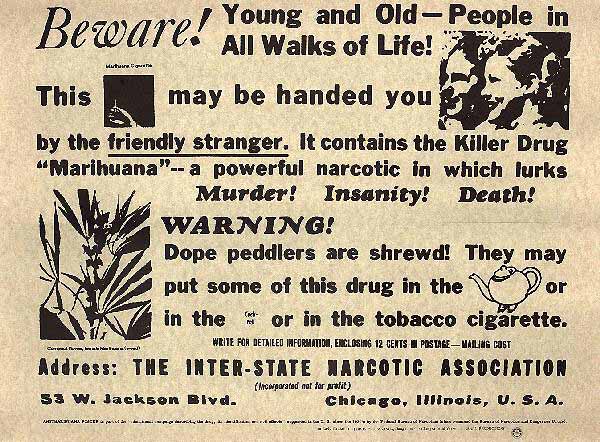Was marijuana legal during the Prohibition Era in Chicago? Guests have asked some variation of that countless times when we’re discussing that time of gangsters and jazzy entertainment. They wonder – if people couldn’t drink booze, then could that at least get stoned?
While recreational marijuana was newly legal in Illinois just about a year ago, the pandemic put a damper on its development. But Chicago sure is readier than ever now in 2021! But what about marijuana in Chicago history? Marijuana played a prominent, if contradictory role, back in the 1920s during the time of Prohibition in Chicago.
In order to research the history of marijuana in Chicago, I had to make sure I had the lingo right. The official names marijuana or hashish are pretty rare in newspapers of the time. Instead, journalists referred to it as “locoweed,” “muta” or “muggie” in slang. I have also heard “jazz cigarette” and, of course, “reefer.” The Spanish spelling, marihuana, was often used, too. In case you want to go retro, then there you go!
Where Was It in Chicago?
During the time of Prohibition, you could find marijuana in various party locales like cabarets, dancehalls, movie houses and nightclubs. And just like the slang term of “jazz cigarette,” it was not unfamiliar in nightclubs where the new and exciting genre of jazz was tied to cultural experimentation in myriad ways.
You could smell weed in hipster joints around Chicago, like the progressive Dill Pickle Club, not far at all from Bughouse Square. You also might encounter a waft of it walking on the streets of “Towertown,” the area just west of today’s Magnificent Mile. It’s hard to imagine that among the mostly corporate restaurants you’ll find here now, in the 1920s this area of Chicago was an artist community. It was full of artist studios, cafes and clubs, and all the “bohemians” that went along with that. Also on the North Side, you could go to Uptown, to the Green Mill (today one of the nation’s oldest continuously running jazz clubs).
On the South Side, Bronzeville’s recording studios, apartment building jam sessions, and nightclubs were full of it, too. Jazz was not just a music but an entire subculture where rules just didn’t matter as much. One jazz musician, Milton “Mezz” Mezzrow, was a clarinetist on the side but most of his income came from his full-time work as a marijuana dealer. He collaborated with Louis Armstrong, a Bronzeville resident and longtime proponent of the joys of smoking weed along with making music. Chicago music and smoking reefer were linked back then just as they are now!
The Moral Panic of Marijuana
The 1936 cult classic Reefer Madness was released just a few years after Prohibition ended. The film is utter propaganda from start to finish. Propaganda like Reefer Madness presented marijuana as a “giggle tobacco” that led to immoral behavior and eventual madness. Jazz came in for a beating, as well, depicted as the gateway, connecting otherwise wholesome teenagers to the “burning weed with its roots in hell.”

This poster from 1971 shows that the sentiment of Reefer Madness was alive and well decades later. The Inter-State Narcotic Association happens to have been based out of our office building at the Monadnock Building in downtown Chicago! It tells people to be careful of the conniving “friendly stranger!” They may even sneak the marijuana into your tea.
Marijuana was Legal During Prohibition
During Prohibition, the Federal Government was busy policing bootleggers and hard narcotics. All the focus was on booze. So state legislatures became the focal points for anti-marijuana crusaders. Under lobbying pressure, state legislators faced a choice as marijuana a medicine to be prescribed, a cigarettes to be taxed, or a narcotic to be banned?
Illinois didn’t ban marijuana until 1931. Which means, yes, marijuana was legal in Chicago during most of Prohibition. Throughout the 1920s, it was legal to get high but not drunk in Chicago.

Why Did the State Eventually Ban Marijuana?
Now let’s ask ourselves the big question, why would states want to outlaw marijuana back then? The campaign against marijuana is complex. Many believe that industrial interests fueled the fear of marijuana in order to protect the paper-making industry’s hemp supply. Others analysts point to a racist campaign against Mexican immigrants. A large number of Mexican emigrants fled to the US in the ’10s and ’20s to escape the violence of the Mexican Revolution. At that time, marijuana was primarily a pharmaceutical in the US, but was mostly smoked recreationally down in Mexico.
While not a ton of Mexican immigrants had settled in Chicago quite yet, they did have distinct communities near the steel mills on the South Side. Factory owners, as they had for a century already, recruited the immigrants en masse as a new source of cheap labor. Then the Great Depression savaged the American job market. This led to a competitiveness around securing jobs. People feared that immigrants would “steal” employment opportunities, and this resulted in a spike in xenophobia. Mexican immigrants were easy scapegoats. Banning a recreational drug associated with Mexican immigrants was an extension of this fear and anger.
Anti-German sentiments during WWI paved the way for the passage of Prohibition in 1919. And thus history may have repeated itself with the illegalization of marijuana in Illinois in 1931. But now you can buy all the weed, edibles, tinctures and anything else imaginable at the city’s new dispensaries. A weed tour company in Chicago will be operating soon. And most of all, maybe our dysfunctional prison system has taken a step towards reform.
– Chicago Detours Staff














